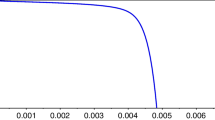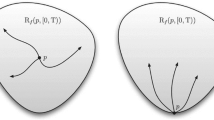Abstract
The construction of attainability and controllability sets for linear systems with discrete time and a total constraint on scalar control in the sense of l1-norm is discussed. For classes of linear systems that are not completely controllable and not completely attainable, the limit sets of controllability and attainability are explicitly constructed, respectively. Examples are given.





Similar content being viewed by others
REFERENCES
D. N. Ibragimov and A. N. Sirotin, “On the problem of optimal speed for the discrete linear system with bounded scalar control on the basis of 0-controllability sets,” Autom. Remote Control 76, 1517 (2015).
A. I. Propoi, Elements of the Theory of Optimal Discrete Processes (Nauka, Moscow, 1973) [in Russian].
A. M. Formal’skii and A. N. Sirotin, “Reachability and controllability sets of linear discrete systems,” J. Comput. Syst. Sci. Int. 41, 507 (2002).
A. M. Formalsky and A. N. Sirotin, “On the geometric properties of reachable and controllable sets for linear discrete systems,” J. Optim. Theory Appl. 122 (2), 17–44 (2004).
A. N. Sirotin, “An exact analytical description of the reachability sets of asymptotically stable linear discrete systems with L 1-norm bounded scalar control,” Vestn. MAI 15, 142-146 (2008).
V. G. Boltyanskii, Optimal Control of Discrete Systems (Nauka, Moscow, 1973) [in Russian].
D. Tabak and B. C. Kuo, Optimal Control by Mathematical Programming (Prentice-Hall, Englewood Cliffs, NJ, 1971).
S. A. Ashmanov and A. V. Timokhov, Optimization Theory in Problems and Exercises (Nauka, Moscow, 1991) [in Russian].
U. S. Polovinkin and M. V. Balashov, Elements of Convex and Strongly Convex Analysis (Fizmatlit, Moscow, 2007) [in Russian].
D. A. Kozorez, M. N. Krasil’shchikov, D. M. Kruzhkov, and K. I. Sypalo, “Autonomous navigation during the final ascent of a spacecraft into the geostationary orbit. Autonomous integrated navigation system concept,” J. Comput. Syst. Sci. Int. 54, 798 (2015).
D. A. Kozorez, M. N. Krasil’shchikov, D. M. Kruzhkov, and K. I. Sypalo, “Integrated navigation system for a space vehicle on a geostationary or highly elliptic orbit operating in the presence of active jam,” J. Comput. Syst. Sci. Int. 52, 468 (2013).
R. T. Rockafellar, Convex Analysis (Princeton Univ. Press, Princeton, 1973).
P. L. Ul’yanov, A. N. Bakhvalov, M. I. D’yachenko, K. S. Kazaryan, and P. Sifuentes, Real Analysis in Problems (Fizmatlit, Moscow, 2005).
A. N. Kolmogorov and S. V. Fomin, Elements of the Theory of Functions and Functional Analysis (Nauka, Moscow, 1981) [in Russian].
R. A. Horn and Ch. R. Johnson, Matrix Analysis, 2nd ed. (Cambridge Univ. Press, Cambridge, 2012).
K. Leichtweiß, Konvexe Mengen (Springer, Berlin, 1980).
Author information
Authors and Affiliations
Corresponding authors
Ethics declarations
The authors declare that they have no conflicts of interest
APPENDIX
APPENDIX
Proof of the lemma. (i). By definition [8, Chap. 2, § 4, point 1] the set \(\mathcal{D} \subset {{\mathbb{R}}^{n}}\) is called a polyhedron if it can be represented as a set of solutions to a system of a finite number \(m\) of linear inequalities:
We denote by \({{\mathcal{B}}_{{\mathbb{R}_{1}^{n}}}}\) a closed ball in \({{\mathbb{R}}^{n}}\) with metric l1:
The set of \({{\mathcal{B}}_{{\mathbb{R}_{1}^{n}}}}\) is a polyhedron, because
where
Indeed, if for \(\alpha \in \mathbb{R}\) and \(\beta \geqslant 0\), the inequality
is valid, then we get
or
Further, the reasoning is carried out by induction. Assume k = 1, then from for any \(x \in {{\mathcal{B}}_{{\mathbb{R}_{1}^{n}}}}\), we find
From (A.2) and (A.3), we have
or
Let us say for an arbitrary \(k = \overline {2,n - 1} \), the following inequality is valid:
Then,
From (A.2) we obtain
Thus, from statement (A.4), (A.5) follows for k, and the validity of assertion (A.4), for k +1. Therefore, by the principle of mathematical induction, we come to the conclusion that the inequality
is equivalent to inequality
which coincides with (A.1).
We introduce the matrix \({{A}_{k}} \in {{\mathbb{R}}^{{n \times \left( {k + 1} \right)}}}\) according to the formula
Assume
Then
Therefore, we get the representation
By [12, Theorem 19.3, Chap. IV, § 19], the set \({{\mathcal{Y}}_{t}}\left( k \right)\) is a polyhedron as a linear mapping of a polyhedral convex set.
(i) The set \({{\mathcal{B}}_{{\mathbb{R}_{1}^{k}}}}\) is, by construction, a closed unit ball centered at 0 in the metric space \({{\mathbb{R}}^{k}}\) with metric l1. Therefore, the set \({{\mathcal{B}}_{{\mathbb{R}_{1}^{k}}}}\) is closed, bounded, and symmetric with respect to 0 as the corresponding ball. Finally, statements (ii) follow from the linear representation
(iii) By the Minkowski-Weyl theorem [8, Chap. 2, § 8, theorem 8.14], the set \({{\mathcal{Y}}_{t}}\left( k \right)\) is a convex polyhedron since it is a bounded polyhedron by (ii).
The following equality is valid
and therefore the following representation is correct:
Indeed, we get
The proof of assertion (iii) is sufficient for t = 1; thus, we denote
The following inclusion is valid:
Indeed, if
then
Let us assume
then
Hence,
By (A.7) we obtain
We now show that the following reverse inclusion is true:
Indeed, assume \(y \in \operatorname{conv} ( \pm b, \pm Ab, \ldots , \pm {{A}^{{k - 1}}}b)\), then the decomposition
Let us put
Then, the following equality is valid:
and also,
This means that by definition
From (A.8) and (A.10), the required assertion (iii) follows.
(iv) Since by construction \(\mathcal{Y}\left( k \right)\) is a nonempty convex set in \({{\mathbb{R}}^{n}}\) and \(0 \in {{\mathcal{Y}}_{t}}\left( k \right)\), by assertion (ii) from [8, Chap. 3, § 7, point 7, theorem 7.14], it follows that \(0 \in \operatorname{ri} {{\mathcal{Y}}_{t}}\left( k \right)\). By condition (1.3) we have \(\operatorname{aff} {{\mathcal{Y}}_{t}}\left( k \right) = {{\mathbb{R}}^{n}}\) and \(\operatorname{ri} {{\mathcal{Y}}_{t}}\left( k \right) = \operatorname{int} {{\mathcal{Y}}_{t}}\left( k \right)\), which proves the claim.
The proofs of statements (v), (vi), and (vii) are obvious.
The lemma is proved.
Proof of the theorem. By assertion (iii) of the lemma, we have
Then from (1.3) and the lemma we deduce that the set \({{\mathcal{Y}}_{t}}\left( n \right)\) is a symmetric bounded convex set for which \(0 \in \operatorname{int} {{\mathcal{Y}}_{t}}\left( n \right)\).
Let us construct a sequence of vectors \({{\{ {{A}^{k}}b\} }_{{k \in \mathbb{N}}}}\). Then there is a number \(K \in \mathbb{N}\) such that
Indeed, by condition (1.4) we have \(\rho \left( A \right) < 1\), then [15, Theorem 5.6.12] the following equality is valid:
Therefore,
By definition of the convergence of a numerical sequence \({{\left\{ {{{{\left\| {{{A}^{k}}b} \right\|}}_{{{{\mathcal{Y}}_{t}}\left( n \right)}}}} \right\}}_{{k \in \mathbb{N}}}}\), there is a natural K such that
Now from (3.3) and (3.4), we obtain the required inclusion (A.11).
For arbitrary vectors \({{a}^{1}}, \ldots ,{{a}^{m}},c \in {{\mathbb{R}}^{n}}\), \(m \geqslant 1\), the equality
if
Indeed, by the definition of a convex hull, the inclusion
However, (A.13) also implies the chain of inclusions
We finally arrive at equality (A.12).
By point (iii) of the lemma, for \(k \geqslant K\)
insofar as
Here equality (A.12) is used. Therefore, by point (v) of the lemma, we conclude
which proves equality (2.1).
The theorem is proved.
Rights and permissions
About this article
Cite this article
Ibragimov, D.N., Osokin, A.V., Sirotin, A.N. et al. On the Properties of the Limit Control Sets for a Class of Unstable Linear Systems with Discrete Time and l 1 -Restrictions . J. Comput. Syst. Sci. Int. 61, 467–484 (2022). https://doi.org/10.1134/S1064230722040104
Received:
Revised:
Accepted:
Published:
Issue Date:
DOI: https://doi.org/10.1134/S1064230722040104




